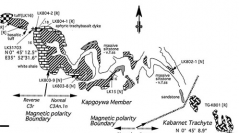

 Comptes Rendus Palevol
1 (5) - Pages 293-303
Comptes Rendus Palevol
1 (5) - Pages 293-303Throughout the history of the East African Rift valley, tectonic depressions and volcanic dams formed within the graben in which Middle Miocene to Recent volcanic rocks and lacustrine to fluvial sediments accumulated. During the Late Miocene, voluminous trachytes erupted in the vicinity of Kabarnet and almost filled the valley to its brim. Continued tectonic activity formed new basins floored by the Kabarnet Trachyte, one of which was located in the region immediately east of the present day Tugen Hills. The Lukeino sediments that accumulated in this basin crop out over an area of 44 km × 13 km. In 2000, Orrorin tugenensis, which is important for understanding the earliest stages of human evolution, was found in the Lukeino Formation
early hominid, Late Miocene, K–Ar age, magnetostratigraphy, chrons C3n to C3r, Lukeino Formation, Kenya